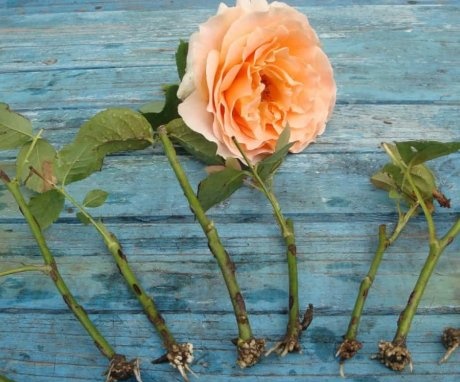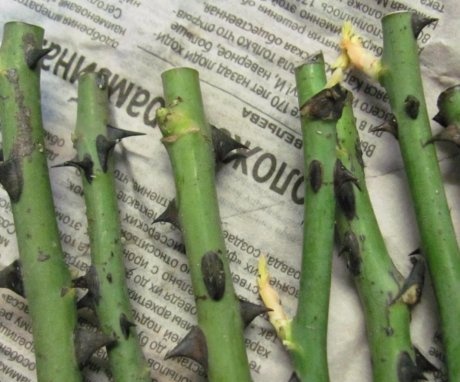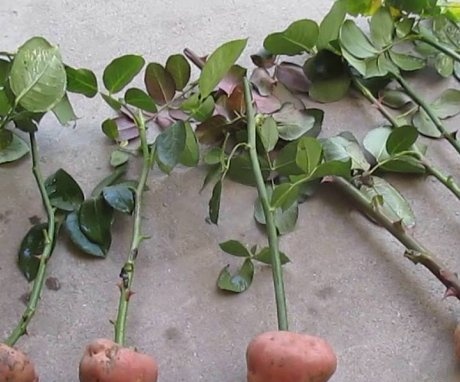A step-by-step guide for beginner gardeners: how to keep rose cuttings until spring
One of the most beautiful garden crops, which is popular among ordinary people and experienced flower growers, is the rose.
The bush propagates in different ways, but experts advise using the grafting method. The peculiarities of the autumn harvesting of planting material and how to preserve the cuttings until spring are described in the article.
How to choose and prune cuttings for storage
The plant from which it is planned to cut the shoots should not have any damage or signs of disease. Twigs with a diameter of a pencil are suitable for blanks. Cuttings of this diameter are more likely to survive and flourish.
Method propagation by cuttings suitable for the following varieties:
- semi-climbing roses;
- climbing varieties of the Rambler group;
- all kinds of polyanthus, miniature roses;
- Flamingant;
- Excelsa;
- Rosalind (Floribunda group);
- Iceberg.
Before pruning, you need to pick up the right bushes. You can recognize the readiness of a plant by how the needles give in to break off. A rose is suitable for harvesting cuttings, in which thorns break easily.
Reference! Cut off shoots with a tool with a sharp blade. It is preliminarily disinfected in boiling water or using antiseptic solutions.
Basic rules for harvesting cuttings:
- shoots with a diameter of 0.4-08 cm are selected;
- the length of the stem between the slices is 12-15 cm;
- a prerequisite is the presence of 2-3 buds or leaves;
- the cut in the upper part of the stem must be made even, the lower one - at a slope of 45 °;
- leaves and thorns on the cut shoot should be torn off;
- to stimulate the rooting process, the lower cut is dipped into a solution prepared from Heteroauxin or Kornevin (can be replaced with sweet water: 200 ml of water and ½ tsp. liquid honey).
When choosing a rose bush for the purpose of harvesting material for propagation, they are guided by the following criteria:
- the color of the shoots should be dark green or light brown;
- a light core is visible on the cut;
- pliability of the skin to separation;
- a lignified layer is felt under the bark.
Pruning time
Cutting roses should be planned for the summer. Suitable months for work: June, July. After the fall pruning, it is a pity to dispose of healthy shoots. They make strong cuttings when properly stored in the winter. Advantages of autumn harvesting: high plant resistance to low temperatures, predisposition to the formation of lateral shoots.
In the spring, you can also do cuttings. Already next season, the first buds will appear on a young bush. But roses obtained from spring cuttings will be vulnerable to winter frosts. Prune the rose to obtain planting material, preferably in the fall.
Optimal conditions for the preservation of the cutting
The workpieces will survive the winter well if you create optimal storage conditions. First of all, it is a stable temperature regime. It should be between + 2 ° and + 5 °. Lower rates lead to freezing of the planting material, high temperatures will provoke the awakening of the shoot.
Petioles, after cutting and processing with a special tool, are formed into a bunch of 10-15 pieces, after which they are sent to a box with sand.In addition to a stable temperature regime, it is necessary to limit the access of bright light. The humidity in the storage should be 65-70%.
In winter, the cuttings are ventilated once a month. To do this, they are removed from a box or other container where the workpieces are stored.
The safety of cuttings will be ensured if the following recommendations are followed:
- freezing of blanks must not be allowed;
- exclude the possibility of drying out the shoots;
- block access to rodents and pests;
- regularly inspect the bookmark (once every 3-4 weeks);
- take measures to preserve the dormant state of the plant (avoid sudden changes in temperature and humidity).
Reference! Most often, when harvesting cuttings in autumn, gardeners propagate several varieties of roses at once. In order not to confuse them in spring when planting, it is recommended to attach a tape with the signed name of the variety to each stalk when laying for winter storage.
Due to a violation of the moisture regime or as a result of a sharp change in temperature, the cuttings can become moldy. If condensation is detected, the cuttings should be washed in an iodine solution or a product based on copper sulfate. It is also necessary to remove condensation in the shelter, to disinfect.
Storage methods
Experienced growers use the following storage methods for storing petioles in winter.
In the snow
This method involves digging holes in the backyard. Its depth should be 15-20 cm. The bottom of the recess is covered with a cotton cloth. Cuttings are laid on top of the litter, on which all the leaves were previously cut off. The twigs are covered with another layer of fabric, after which the hole is covered with soil.
Reference! The edges of the fossa should be marked with peg marks. This will make it possible to navigate where the bookmark is located.
In the first half of March, I dig out the workpiece and examine it for callus. This is an overgrown tissue from where roots germinate. The petioles are sent to the prepared hole for the further development of the plant.
On the balcony
It doesn't matter if the farm does not have a basement, and trips to the dacha in winter are stressful. A favorable environment is available to create on the balcony. To do this, you will need a wooden box, a little expanded clay and a soil mixture that is suitable in composition (you can take it ready for flowers).
The container is installed in the warmest zone, filled with expanded clay (a layer of about 8-10 cm) and a substrate (20-35 cm). Experienced gardeners advise moisturizing with a spray bottle
The petioles are laid in the following order:
- first, each workpiece is dipped in water;
- after that, there is a treatment with a tool that activates the growth of roots (the stalk must also be dipped into a liquid with a diluted drug);
- landing in the ground;
- the box is wrapped with plastic wrap, and then a warm blanket.
Periodically, the planting is ventilated and moderately moistened with the settled liquid.
In the basement
This is the ideal storage for planting material. There is no need to create special conditions. The air temperature in the underground room varies from 2 to 5 degrees, humidity is also normal (about 60%). Contains cuttings in a large container or bucket filled with sand or soil. When using ordinary soil, it is necessary to lighten it with perlite or peat.
After moistening the substrate, cuttings are installed in the container. A frame is constructed on top of the landing, on which a darkened film is held. Shoots should be ventilated periodically. The degree of soil moisture is also monitored.
In a refrigerator
A refrigerator can serve as a storage for petioles with a favorable environment. For this, the vegetable compartment is freed from the products. A plastic bag is put into it, which is filled with bundles of cut and processed shoots.
To maintain a stable temperature and humidity, it is recommended to wrap the planting material in a damp cotton cloth.This method is advisable for a small number of cuttings.
Under the rose bushes
Another simple option for storing blanks involves dropping them under a rose bush. It is convenient to do this when breeding several varieties at the same time. The petioles are hidden under a layer of soil under the flowers of the corresponding variety. The bookmarking process consists of the following steps:
- digging a hole (depth about 15 cm);
- covering the bottom with a cotton cloth;
- filling the recess with cuttings (no more than 10-15 shoots are placed in one hole);
- laying cotton fabric on top of blanks;
- backfill soil.
In the soil
This method is suitable for regions with a warm climate. The essence of the method consists in planting the petiole immediately after separation from the stem of the bush and processing. The workpiece is buried in the soil, setting it with a slope (approximately 45 °). Only a third of the cutting is left on the surface.
The protruding part above the ground level is covered with a plastic bottle, the bottom of which has been cut off. For ventilation, it is recommended to make small holes on the sides. Before the onset of frost, the planting is covered with a layer of lutrasil or dry foliage.
There is another option for storing cuttings in the soil. To do this, the workpiece is buried in a hole, following the rules for keeping planting material under rose bushes.
Rooting for storage
You can germinate the workpieces using sphagnum or potatoes.
With moss
To begin with, a suitable moss is selected. Sphagnum is suitable for sprouting rose petioles. It must be treated with Fitosporin before use. The lower cut of the shoots is dipped in a solution that stimulates the rapid germination of roots.
After the preparation of the planting material, the workpieces are wrapped in moss, placed in this form in a polyethylene bag. After a layer of sphagnum, you can make an interlayer of newspaper, then put the roll in polyethylene.
In this form, the material is stored in a cool place until spring. In the first days of March, you can start rooting blanks. The workflow includes the following steps:
- unpacking cuttings;
- trimming thorns;
- filling the box with moss and river sand (layer at least 3 cm);
- moistening with settled liquid (from a spray bottle);
- planting cuttings;
- creating a greenhouse effect by fixing plastic wrap to the sides of the box.
A warm environment without access to sunlight is suitable for germinating roots. Humidification and ventilation are carried out periodically. After 1-1.5 months, the cuttings can be transferred to the garden bed.
In a potato tuber
The root vegetable is saturated with starch and other valuable microelements. Therefore, potatoes are able to create a favorable environment for sprouting roots. To complete the work, you will need to choose healthy medium-sized vegetables, cut out the eyes, treat with a fungicide for disinfection.
The shoots are pre-cleaned of leaves, the cut from the bottom is moistened in a weak solution of potassium permanganate. Small holes are made in the potato with a size that corresponds to the thickness of the workpiece. It remains only to stick them into the roots and install them in a container. Potassium permanganate solution is used as an irrigation liquid. Each petiole is closed with a glass jar.
Periodically, the upset must be removed from the polyethylene to admit oxygen. Also, taking into account the degree of moisture evaporation, moderate watering is performed. For irrigation, it is recommended to use sweetened water (1 tablespoon sugar is taken for 250 ml of liquid).
How to check the safety of the cuttings in spring
With the onset of spring, the active awakening of plants begins. Cuttings fit to prepare for planting. But first you need to check how the material survived the winter. This must be done just before landing (about a day). Until then, the cuttings should remain in cool storage.
The following signs will help to determine the quality of the harvesting after winter keeping in a special shelter:
- when bending the shoot, elasticity and elasticity are felt;
- the bark has a fresh appearance, there is no wrinkling (dry and twisted stalk is not used due to lack of vitality);
- on the cut, the wood should be light green and fresh (brown or dark color indicates the death of the workpiece);
- tight fixation of the kidneys;
- smooth kidney scales, elastic structure;
- a light green tab should open in the cut kidney (brown content indicates poor cutting quality).
Often, storage of blanks for the propagation of a rose turns into freezing of the material. In the spring, when the material is opened, the following test can be performed.
- Update slices that are sloped at 45 degrees. It is enough to shorten the workpiece by 0.8-1 cm.
- Place the cuttings in a container of clean water. If they are healthy, the liquid will remain clear. If a yellowish-brown cloudiness is detected, the material is discarded due to freezing.
It is not worth using low-quality or spoiled material for the propagation of roses, such shoots will not be accepted in the soil due to the loss of vitality.
Related videos:












I love roses very much and I grow them every year in the front garden. I began to propagate cuttings recently, I liked it. I keep them in the cellar or I dig them right into the ground. Some may die, of course, but not all. Large often tolerates winter well.
If you cut a rose in the summer, then you can not store the cuttings until next spring, but germinate them immediately. The rose obtained in this way will bloom well, but its frost resistance will be low.